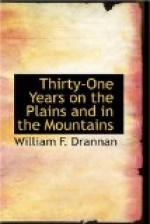Jim Bridger proposed that he and I make a trip to Fort Kearney together, and remain there until the emigrants began to come along, thinking that perhaps the Sioux would be so bad on the plains again that summer that we might get a layout scouting for trains going to California. Both of us were well acquainted with a greater part of the country to be traveled over, and there were few other men as well posted as to where the Indians were likely to make attacks, which was one of the most essential requirements in scouting with a train.
About the first of April we started, by the way of Denver City, for Fort Kearney, and as it had been nearly a year since we had seen the first named place we found quite a change there. Instead of a tented town, of shreds and patches, we saw a thriving village that had some quite comfortable wooden houses and an air of distinct civilization. To-day Denver is probably the best built city of its size in the world, but there was a time after this present visit of mine and Bridger’s when the place became almost deserted. That was when the Union Pacific railroad was being constructed to Cheyenne, leaving Denver one hundred and eight miles due south. Then, all the people in Denver who could raise any sort of a team, took their household goods and gods, and in some cases the houses, and struck out for Cheyenne. Many who were too poor to get away became enormously rich, afterward, from that very fact, for they became possessed of the ground, and when the Kansas Pacific railroad was projected, and afterward constructed, Denver took on such a boom that real estate nearly went out of sight in value. The poor ones became wealthy, and nearly all of the Cheyenne stampeders returned. Following this, some years afterward, the discovery of silver carbonates in California Gulch, where Leadville now stands, gave Denver another boom that made the place the Queen city of the Plains, for good and all.
We reached Fort Kearney before the emigrants had got that far out, and found Gen. Kearney in command. He was glad to see us, and told us that if we needed any references to send the parties to him and he would give us a send-off that would be likely to fix us all right, and we knew that it would.
“I predict more trouble,” said he, “on the plains this summer than there ever has been in any season previous to this, from the fact that the northern Sioux are, even at this early date, breaking up into little bands, and no doubt for the express purpose of capturing small bands of emigrants crossing the plains the coming summer.”
The first train that came along was from Illinois and Missouri. It was on the way to California and was composed of sixty-four wagons. The company was made up of men, women and children, nearly all of the men having families. They camped about a mile from the fort, and at near sundown Gen. Kearney proposed that we go over and see the ladies. So we rode over—the General, Jim Bridger and I.




